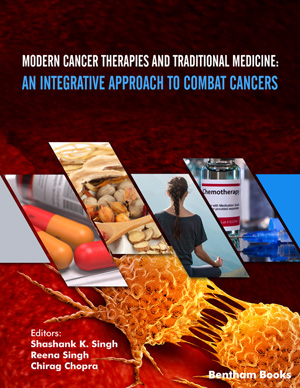Abstract
Background: As a novel pillar for lung adenocarcinoma (LUAD) treatment, immunotherapy has limited efficiency in LUAD patients. The nucleic acid sensing (NAS) pathways are critical in the anti-tumor immune response, but their role in LUAD remains controversial.
Objective: The study aims to develop a classification system to identify immune subtypes of LUAD based on nucleic acid sensing-related genes so that it can help screen patients who may respond to immunotherapy.
Methods: We performed a comprehensive bioinformatics analysis of the NAS molecule expression profiles across multiple public datasets. Using qRT-PCR to verify the NAS genes in multiple lung cancer cell lines. Molecular docking was performed to screen drug candidates.
Results: The NAS-activated subgroup and NAS-suppressed subgroup were validated based on the different patterns of gene expression and pathways enrichment. The NAS-activated subgroup displayed a stronger immune infiltration and better prognosis of patients. Moreover, we constructed a seven nucleic acid sensing-related risk score (NASRS) model for the convenience of clinical application. The predictive values of NASRS in prognosis and immunotherapy were subsequently fully validated in the lung adenocarcinoma dataset and the uroepithelial carcinoma dataset. Additionally, five potential drugs binding to the core target of the NAS signature were predicted through molecular docking.
Conclusion: We found a significant correlation between nucleic acid sensing function and the immune treatment efficiency in LUAD. The NASRS can be used as a robust biomarker for the predicting of prognosis and immunotherapy efficiency and may help in clinical decisions for LUAD patients.
Graphical Abstract
[http://dx.doi.org/10.1016/j.ccm.2019.10.001] [PMID: 32008623]
[http://dx.doi.org/10.1056/NEJMoa1606774] [PMID: 27718847]
[http://dx.doi.org/10.1016/bs.ircmb.2018.11.002]
[http://dx.doi.org/10.1146/annurev-immunol-032713-120156]
[http://dx.doi.org/10.1021/acs.molpharmaceut.8b00691] [PMID: 30226786]
[http://dx.doi.org/10.1016/j.cell.2019.05.003] [PMID: 31155231]
[http://dx.doi.org/10.1038/s41590-021-00886-5] [PMID: 33707781]
[http://dx.doi.org/10.1038/s41467-021-23004-3] [PMID: 33976222]
[http://dx.doi.org/10.1158/2159-8290.CD-19-0761] [PMID: 31852718]
[http://dx.doi.org/10.1038/s41392-020-0150-x] [PMID: 32355263]
[http://dx.doi.org/10.1038/nri.2016.78] [PMID: 27455396]
[http://dx.doi.org/10.1126/sciadv.abf6290] [PMID: 34613770]
[http://dx.doi.org/10.2174/1573409915666190206142756] [PMID: 30727910]
[http://dx.doi.org/10.1016/j.jics.2021.100088]
[http://dx.doi.org/10.1016/j.jics.2021.100082]
[http://dx.doi.org/10.1007/s11224-022-01879-2]
[http://dx.doi.org/10.1038/s41598-022-20325-1] [PMID: 36180452]
[http://dx.doi.org/10.1073/pnas.0506580102] [PMID: 16199517]
[http://dx.doi.org/10.5114/wo.2014.47136] [PMID: 25691825]
[PMID: 23193258]
[http://dx.doi.org/10.1002/path.5026] [PMID: 29282718]
[http://dx.doi.org/10.1158/0008-5472.CAN-11-1403] [PMID: 22080568]
[http://dx.doi.org/10.1158/1078-0432.CCR-12-1139] [PMID: 23032747]
[http://dx.doi.org/10.1158/1078-0432.CCR-07-4937] [PMID: 19010856]
[http://dx.doi.org/10.1097/JTO.0000000000000042] [PMID: 24305008]
[http://dx.doi.org/10.1093/annonc/mdx518] [PMID: 28950298]
[http://dx.doi.org/10.1038/s12276-020-00493-8] [PMID: 32879421]
[http://dx.doi.org/10.1038/s41467-019-12159-9] [PMID: 31537801]
[http://dx.doi.org/10.1023/A:1023949509487]
[http://dx.doi.org/10.1016/j.foodchem.2009.07.058]
[http://dx.doi.org/10.1016/j.jmb.2019.11.016] [PMID: 31786265]
[http://dx.doi.org/10.1038/s41590-022-01132-2] [PMID: 35145297]
[http://dx.doi.org/10.7150/jca.17648] [PMID: 28382138]
[http://dx.doi.org/10.1186/s12964-020-0530-4] [PMID: 32264958]
[PMID: 33290271]
[http://dx.doi.org/10.1136/jitc-2019-000340] [PMID: 32461345]
[http://dx.doi.org/10.1038/s41598-021-90500-3]
[http://dx.doi.org/10.1371/journal.ppat.1003649] [PMID: 24098118]
[http://dx.doi.org/10.1016/j.tice.2022.101918]
[http://dx.doi.org/10.1155/2021/5542485]
[http://dx.doi.org/10.3389/fimmu.2022.1008727]
[http://dx.doi.org/10.3389/fimmu.2012.00079]
[http://dx.doi.org/10.1097/01.PCC.0000288717.44702.C0] [PMID: 17906593]
[http://dx.doi.org/10.3390/ijms21249418] [PMID: 33321934]
[http://dx.doi.org/10.3390/biology11020246] [PMID: 35205112]
[http://dx.doi.org/10.21873/anticanres.14544] [PMID: 32988855]
[PMID: 29724295]
[http://dx.doi.org/10.1021/bi201159b] [PMID: 22304499]
[http://dx.doi.org/10.4331/wjbc.v6.i4.409] [PMID: 26629323]
[http://dx.doi.org/10.1016/j.tranon.2021.101272] [PMID: 34823094]
[http://dx.doi.org/10.1158/1535-7163.MCT-21-0943] [PMID: 35732501]






















